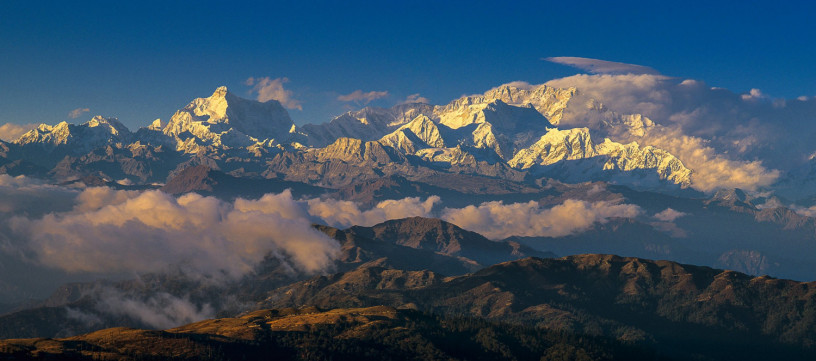Kangchenjunga: The Majestic Mountain of Taplejung, Nepal Professional
Jul 9th, 2024 at 13:36 Blogs Taplejung 332 views Reference: 1381Location: Taplejung
Price: Contact us
Kangchenjunga: The Majestic Mountain of Taplejung, Nepal
Kangchenjunga, the third highest mountain in the world, stands tall at 8,586 meters (28,169 feet) and is a prominent landmark in the Taplejung District of eastern Nepal. Known as the "Five Treasures of Snow," Kangchenjunga is a breathtaking natural wonder, revered for its majestic peaks and spiritual significance. The mountain and its surrounding region offer a unique blend of natural beauty, cultural richness, and adventurous opportunities, making it a must-visit destination for trekkers and nature enthusiasts.
Historical and Cultural Significance
Kangchenjunga holds immense cultural and spiritual significance for the local communities. The name "Kangchenjunga" is derived from the Tibetan words 'Kang-chen-dzo-nga,' meaning "Five Treasures of the Great Snow," which refer to the mountain's five summits. These summits are believed to symbolize the five repositories of God, which are gold, silver, gems, grain, and holy books.
The mountain is sacred to the indigenous people of the region, particularly the Limbu community, who consider it the abode of their deities. The spiritual reverence for Kangchenjunga is reflected in various local myths, legends, and rituals.
Geographical and Ecological Features
Kangchenjunga is located in the eastern Himalayas, straddling the border between Nepal and the Indian state of Sikkim. The mountain is part of the Kangchenjunga Conservation Area, which encompasses a diverse range of ecosystems, from subtropical forests to alpine meadows and glaciers.
The region is renowned for its rich biodiversity. The lower regions of the conservation area are home to a variety of flora, including rhododendrons, orchids, and bamboo. As one ascends, the vegetation transitions to alpine shrubs and meadows, culminating in snow-covered peaks and glaciers. The area also supports a wide array of wildlife, such as the elusive snow leopard, red panda, Himalayan black bear, and various species of birds.
Trekking and Adventure
Trekking in the Kangchenjunga region is an unforgettable experience, offering stunning vistas, challenging trails, and a deep cultural immersion. The Kangchenjunga Base Camp Trek is one of the most popular trekking routes, taking adventurers through diverse landscapes and remote villages. The trek can be approached from both the south and north base camps, each offering unique perspectives and experiences.
1. South Base Camp Trek
Starting from Taplejung, the south base camp trek leads through lush valleys, terraced fields, and dense forests. Key highlights include passing through the villages of Yamphudin, Tortong, and Ramche, and witnessing the magnificent Yalung Glacier. The trek culminates at the Oktang viewpoint, offering panoramic views of Kangchenjunga's southern face.
2. North Base Camp Trek
The north base camp trek begins from the village of Sekathum and takes trekkers through the picturesque Ghunsa Valley. Key stops include the villages of Ghunsa, Kambachen, and Lhonak, before reaching the Pangpema viewpoint, which provides awe-inspiring views of the northern face of Kangchenjunga.
Both treks require a good level of fitness and preparedness, as they involve long days of walking, high altitudes, and rugged terrains. However, the rewards are immense, with unparalleled natural beauty and cultural encounters along the way.
Cultural Encounters
The Kangchenjunga region is home to diverse ethnic communities, including the Limbus, Sherpas, and Rai, each with their own distinct cultures, languages, and traditions. Trekkers have the opportunity to experience the warm hospitality of these communities, learn about their way of life, and participate in local festivals and rituals.
Visitors can explore traditional Limbu villages, visit monasteries, and witness unique cultural practices such as chasok tangnam (Limbu harvest festival) and losar (Tibetan New Year). The cultural richness of the region adds a profound dimension to the trekking experience.
Conservation Efforts
The Kangchenjunga Conservation Area Project (KCAP) was established in 1997 with the aim of preserving the unique biodiversity and cultural heritage of the region. The project focuses on sustainable development, community involvement, and conservation education. Efforts include protecting endangered species, promoting eco-tourism, and supporting local livelihoods.
Conclusion
Kangchenjunga, with its towering peaks, pristine landscapes, and rich cultural heritage, is a jewel of Nepal's eastern Himalayas. The mountain's grandeur and the surrounding region's natural and cultural treasures make it a premier destination for trekkers, nature lovers, and cultural enthusiasts. As visitors explore this majestic mountain and its environs, they not only witness the breathtaking beauty of the Himalayas but also contribute to the conservation and sustainable development of this precious region.




